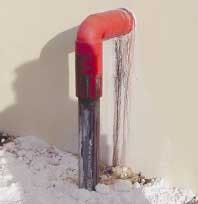Click here to enlarge imageSulfuric acid with a concentration of 98% is typically supplied in a concentration range from 98.1 to 98.9%. This has led to the new common terminology of 98+% sulfuric acid. This 98+% sulfuric acid (with SO3) attacks both PVDF pipe and steel pipe.
A copolymer of ethylene and chlorotriflouroethylene (E-CTFE), commonly known as HALAR™, is a proven solution for these problems. This material has been successfully tested and used in sulfuric acid and sulfur trioxide applications.
Halar piping systems are generally more expensive than PVDF systems. However, 98% sulfuric acid is approximately 20% less expensive than 93%, depending on the supplier. A typical plant serving 140,000 residents will use 1,600 gallons of 93% acid per day. Switching to 98% acid will reduce consumption by roughly 4%. Therefore, a typical plant can expect a savings of more than $35,000 per year by using the higher concentration of sulfuric acid.
Design Considerations
While selecting the proper piping material is critical for smooth operation in water treatment plants, it is also important to consider the piping design and installation method. For best results, the piping system supplier should be involved in these recommendations.
Government regulations and required protective measures may help determine the design and installation. Piping is both above grade and below grade. Above grade piping has a single wall configuration. However, when running the pipe underground, it must be double contained using a double wall configuration to protect the ground water. This is an EPA guideline, according to the Code of Federal Regulation, 40 CFR 280. In pump houses where sulfuric acid is pumped up to higher pressures of 60 to 100 psi, it is common that pipe is placed behind protective plastic doors for safety reasons.
Other design considerations involve determining the most effective and efficient methods to obtain specific goals. At an injection well used in chemical dosing, there are a number of options for effective injection of the acid into the main water supply. A recommended process is to use an injection quill, which will inject the chemical into the center of the pipe, creating a better blend of acid in the water.
During periods of interruption to the acid feed, water will flood into the injection line, creating an exothermic reaction as high as 180° to 200°F in the pipeline. To minimize the thermal stress, check valves should be utilized to prevent water back flow.
Conclusion
When making the final decision on which piping material to choose for chemical dosing applications, it is important to consider a material that provides low maintenance and, more importantly, chemical resistance to all grades of acid that could be used over the life of a facility. Halar piping systems can provide safety, reliability and cost savings to municipal water treatment facilities using higher strength acids. The material's resistance to both sulfuric acid and the common contaminant of SO3 makes it an ideal choice for a piping material.
Halar is a registered trademark of the Solvay Solexis Co.
About the author
Scott Robichaud is the Executive Vice President at Asahi/America, Inc. of Malden, MA. He has a B.S. degree in Chemical Engineering from the University of New Hampshire and MBA from Boston College. Asahi/America is a long term supplier and manufacturer of high purity wet process components.




